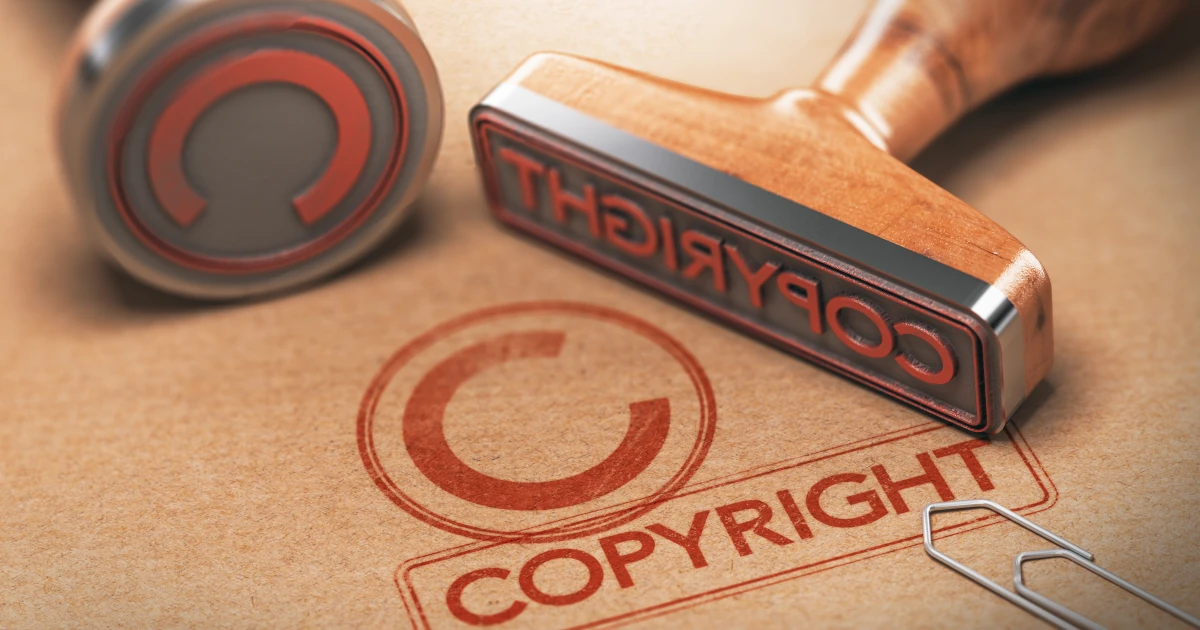What’s the Difference Between a Trademark and Copyright?
Want to protect your intellectual property? This guide explains the difference between a trademark and copyright and which is best for your business.


A trademark is a word, phrase, or symbol that grants you exclusive rights to your brand, product, or service.
Copyright is an intellectual property that protects your literary, digital, or other creative work from unauthorized use.
The best way to apply for a trademark or copyright is to use a reliable trademark or copyright filing service.
In today’s competitive business world, others may try to replicate or outright steal your intellectual property. You can use several tools to protect your product or service, including a trademark and copyright.
Any discussion around trademark vs. copyright comes down to which one is more suitable for your company. The only way to know for sure is to understand the difference between trademark and copyright mechanisms. This article will do just that.

What Is a Trademark?
According to the United States Patent and Trademark Office (USPTO), a trademark is a word, symbol, or phrase that distinguishes your enterprise from others.[1] A successful trademark application protects you from trademark infringement, which involves other companies using the same or overtly similar words to promote their offerings.
Once you complete the federal trademark registration process, you get a registered trademark that grants you legal protection and exclusive rights to your intellectual property.
When choosing your trademark, the key is to be original. You can use a trademark search to avoid overlaps with your competitors.
Types of Trademarks
“Trademark” is a broad term. There are multiple types of trademarks, depending on what they imply about your company:
Generic Mark
Generic trademarks are the weakest form of trademark. In fact, the USPTO doesn’t even recognize most generic trademarks as legitimate. That’s because they only describe the nature of a business rather than what makes it unique.
For instance, suppose you’re in the furniture manufacturing business. If you want to trademark something like “Furniture Store,” you’ll probably be denied because the term is too broad. Chances are, there are millions of other providers whose business can be described the same way, making this a generic mark.
Descriptive Mark
A descriptive mark indicates a specific feature of your offering that sets the product apart.
Let’s once again assume you’re in the furniture industry. A product name like “office chair” would be a generic name. On the other hand, something like “Next-Gen Office Comfort” would be a descriptive mark.
Similar to generic marks, descriptive marks are typically not eligible for registration. You can only register a descriptive mark if you provide proof that it has acquired a secondary meaning in the mind of the public. This means that, over time, consumers have connected the mark distinctively to your product or service.
Suggestive Mark
Another type of trademark you can consider is suggestive marks. These trademarks imply a certain product quality and require others to use their imagination to connect the offering and your company.
For example, the name of the company LEGO is an abbreviation of a Danish phrase that means “play well.” The correlation is clear once you think about it – kids and adults can use the interlocking plastic bricks to have fun and play well.
Fanciful Mark
Using something entirely original is the best way to avoid clashes with competitor trademarks. That’s where fanciful marks come in. These terms are 100% unique and made up, so they can’t be considered violations of trademark laws.
Some of the most popular companies leverage fanciful marks. Adidas and Nike might be the most famous examples.
Arbitrary Mark
Arbitrary marks include a common word or phrase that has nothing to do with the products offered under the word or phrase.
Take Apple as an example. Everyone knows what an apple fruit is, but it’s unrelated to Apple smartphones or iPads. Arbitrary marks also provide high trademark protection for their originality.
Service Mark
A service mark is similar to a trademark. However, trademarks are used by companies that offer products. On the other hand, service marks are reserved for enterprises that provide services. Every other aspect is the same, meaning you register your service mark with the same organization (USPTO).
There are countless examples of service marks. For instance, let’s say you’re a landscaping company. Your logo may contain a lawn mower and a well-trimmed bush. This could be your service mark. Likewise, you could also protect your name if it’s descriptive enough.
How Long Does a Trademark Last?
In general, trademarks last for as long as you use them. They typically don’t have an expiration date, meaning you can hold onto your trademark if you operate under the same brand name or offer the same products/services the mark represents.
However, this doesn’t mean you should put your feet up after registering a trademark. You must renew it between the fifth and sixth year, the ninth and tenth year, and every ten years after that. You will renew your trademark by providing the USPTO with so-called maintenance documents.[2]
Trademark Application Process
From start to finish, the trademark application process normally looks like this:
Choose your mark.
Select the right filing basis (use in commerce, intent-to-use, or foreign registration).[3]
Create a USPTO account and submit your application via the TEAS portal.
Wait for the USPTO to review your request and approve the trademark.
The process may sound straightforward, but it’s incredibly complex. You must submit many papers, and filling them out correctly is challenging. It also takes the USPTO between 12 and 18 months to review your application and approve a trademark.
Thankfully, there are ways to speed up the procedure and ensure a proper submission:
Outsource the work to a dedicated trademark application service.
Utilize a user-friendly trademark search platform to learn if the desired trademark is available faster.
Select a strong mark (arbitrary or fanciful) to increase approval odds.
Request an expedited trademark if you can provide the USPTO with a compelling reason.

What is Copyright?
The U.S. Copyright Office defines copyright as an intellectual property that safeguards your work as soon as you produce it using a tangible medium.[4] A tangible medium or tangible form can refer to many things, such as film, canvas, digital format, and paper.
As a result, you can copyright books, movies, code, software, songs, and many other authored projects.
What Does Copyright Protect?
Many works of authorship can receive copyright protection:
Musical works, including notes and songs
Dramatic works, including plays
Choreographies, including band and dance routines
Sculptural and photography works, including drawings, paintings, sculptures, and photographs
Motion picture works, including movies, TV shows, video games, slideshows, and commercials
Sound recordings, including sound effects and audiobooks
Architectural works, including architectural and building plans
Whatever you want to copyright, it must meet the following three aspects:
Original: An original work is any work created independently by a human without copying.
Creative: A creative work is any work developed by a human using their creative spark.
Tangible medium: A work fixed on a tangible medium can be communicated using different means, such as visual and video formats.
Once your work is copyrighted, someone can only use your work without your permission for specific purposes, such as teaching, research, scholarship, comments, criticism, and news reports.[5] This is known as “fair use.”
How Long Does Copyright Last?
You can use copyright to protect your works and file a copyright infringement claim, but does your copyright expire after a certain period? The short answer is yes.
The length of your copyright depends on various factors. Primarily, you need to consider when you first published your intellectual property. The creation of anything after 1978 has copyright protection for as long as you’re alive, plus an extra seven decades.
For anonymous work, copyright protection generally applies for 95 years from the year of the initial publication or 120 years from the year of the creation, whichever expires first.[6]
Copyright Application Process
The copyright application process is fairly similar to the trademark registration process. The differences lie in the required paperwork and relevant body.
Here’s how you can apply for your copyright:
Visit the Electronic Copyright Office (eCO) website.
Enter your login credentials or create an account.
Find and fill out the correct registration form, depending on the type of work you want to copyright, such as artistic works, visual, single serials, performing arts, and sound recording projects.
Submit the document to the eCO website and wait for approval. It takes the U.S. Copyright Office approximately three to six months to process your request.
If you think the registration process will take too long, there are two ways to expedite it:
Apply for special handling, which requires the Copyright Office to prioritize your application. To be eligible, you must be nearing publishing or contract deadlines, have urgent customs matters, or be facing potential or ongoing litigation.
Outsource the work to a copyright registration service where you only provide basic information about your work and leave the rest to a professional.
Trademark vs. Copyright
The basics of both trademarks and copyrights have been outlined, and it’s clear they’re different in many ways. Let’s discuss the main differences for your business.
Intellectual Property Protection
A trademark shields your service or product names, logos, and slogans from unauthorized use through words and phrases.
Copyright shields your original works of authorship from unauthorized use. The list includes literary works, movies, TV shows, software code, video games, lyrics, and sound recordings.
Symbol
The universal trademark symbol is TM, SM, and R (TM, SM, ®).
The universal copyright symbol is C (©).
Organization
If you need a trademark, you file the necessary paperwork with the USPTO.
If you need a copyright, you file the necessary paperwork with the U.S. Copyright Office.
Duration
Trademark intellectual property protection lasts for as long as you use the product or service the trademark represents. However, you must keep up with trademark renewal deadlines to keep it alive.
Copyright intellectual property protection lasts throughout the author’s life and 70 years after that. An anonymously published work is copyrighted for 95 years after the initial publication or 120 years after the creation, whichever is shorter. There’s no need to renew a copyright.
Which Is Right for You?
There's no right and wrong when comparing a trademark to copyright. The choice comes down to what you’re trying to protect from infringement.
You should apply for a trademark if you’re a business that needs to shield its products, services, logos, slogans, and other brand identity-related aspects. You should apply for copyright if you’re the creator of an authorship work, such as a song, movie, TV show, video game, or code.
While trademarks and copyrights are a must, the filing process is lengthy. Plus, it’s easy to make a mistake due to the many documents you must provide.
As a dedicated filing service, we can file for your copyright or trademark on your behalf. Just answer a few basic questions, and that’s it. Our team will collect and submit the necessary documents to help you speed up the process and avoid errors.
FAQs
Is it better to trademark or copyright a name?
The decision to trademark or copyright a name depends on what you’re trying to protect. Trademarks apply to business names (e.g., Coca-Cola), products, logos, and services, whereas copyrights apply to literary works, music pieces, TV shows, and other content.
What is the main difference between copyright and a trademark?
Copyright protects authorship works, such as books, lyrics, and computer programs, while a trademark protects the intellectual property of business owners, like a logo, product, or service name.
Do I need both a trademark and copyright?
It depends on what you’re trying to protect. You will need to determine what works best for you under intellectual property rights.
Is a trademark stronger than copyright?
Not necessarily. Since trademarks and copyrights protect different elements, it’s hard to say which one is stronger under intellectual property laws.
What is the purpose of copyright?
Under Copyright Law in U.S. Code, copyright protects your creative works, such as books, songs, choreographies, and TV shows, from unauthorized use.
What are the benefits of trademarking?
The most significant benefit of trademarking is that no other company can reuse your logo or the name of a product or service without legal consequences.
How much does it cost to trademark a name?
The cost of trademarking a product, service, or company name varies, but the U.S. Patent and Trademark Office typically charges a $250-$750 fee.
How long does a trademark last?
A trademark lasts for as long as you use the product, service, or name you want to trademark. It must be renewed every ten years.
Trademark Engine is not a law firm and none of the information on this website constitutes or is intended to convey legal advice. General information about the law is not the same as advice about the application of the law in a particular factual or legal situation. Individual facts and circumstances as well as legal principles including but not limited to the ones referenced on this website can affect the outcome of any given situation. The contents of the above blog is the expression of the author and has not been edited or reviewed by Trademark Engine for accuracy or currentness.
Trademark Engine cannot and does not guarantee that an application will be approved by the USPTO, that a mark will be protected from infringement under common US trademark law, or that any ensuing litigation or dispute will lead to a favorable outcome. If you want or have an interest in obtaining legal advice with respect to a specific situation or set of circumstances, you should consult with the lawyer of your choice.
Bibliography
USPTO. “What Is a Trademark.” Accessed October 5, 2023.
USPTO. “Keeping Your Registration Alive.” Accessed October 5, 2023.
USPTO. “Basis.” Accessed October 5, 2023.
U.S. Copyright Office. “What Is Copyright?” Accessed October 5, 2023.
University of California. “Fair Use for Teaching and Research.” Accessed October 5, 2023.
U.S. Copyright Office. “How Long Does Copyright Protection Last?” Accessed October 5, 2023.
Trademarket Blog
Everything you need to know about starting your business.
Each and every one of our customers is assigned a personal Business Specialist. You have their direct phone number and email. Have questions? Just call your personal Business Specialist. No need to wait in a pool of phone calls.
Trademark Engine provides information and software only. Trademark Engine is not a "lawyer referral service" and does not provide legal advice or participate in any legal representation. Use of Trademark Engine is subject to our Terms of Service and Privacy Policy.